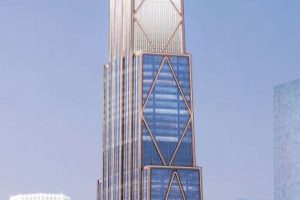Skyscrapers are defined as buildings that rise very high above the ground, typically exceeding 150 meters (492 feet) in height. The term “skyscraper” was first used in the late 19th century to describe the tall buildings being constructed in Chicago, United States. Today, skyscrapers are found in cities all over the world and serve a variety of purposes, including commercial, residential, and mixed-use.
Skyscrapers offer several advantages over traditional low-rise buildings. They can accommodate more people and businesses in a smaller area, making them ideal for dense urban environments. Skyscrapers can also be more energy-efficient than low-rise buildings, as they can be designed to take advantage of natural light and ventilation. Additionally, skyscrapers can be iconic landmarks that define a city’s skyline and attract tourism.
The construction of skyscrapers has been made possible by advances in engineering and technology. In the early days of skyscraper construction, architects and engineers had to overcome challenges such as wind resistance and fire safety. Today, skyscrapers are built using a variety of innovative materials and techniques that make them safe and durable. The tallest skyscraper in the world is the Burj Khalifa in Dubai, United Arab Emirates, which stands at 828 meters (2,717 feet) tall.
1. Engineering and technology
Engineering and technology play a crucial role in determining how high a skyscraper can be built. Skyscrapers are subjected to various forces, including gravity, wind, and seismic activity. Engineers must design skyscrapers to withstand these forces while also ensuring that they are safe and habitable for occupants.
- Structural systems: Skyscrapers use a variety of structural systems to support their weight and resist lateral forces. These systems include frames, trusses, and shear walls. The choice of structural system depends on the height and shape of the skyscraper, as well as the local environmental conditions.
- Materials: Skyscrapers are built using a variety of materials, including steel, concrete, and glass. The choice of materials depends on the structural system used, as well as the desired aesthetic appearance. Steel is strong and lightweight, making it ideal for high-rise construction. Concrete is also strong and durable, but it is heavier than steel. Glass is used for exterior walls to allow natural light to enter the building.
- Construction methods: Skyscrapers are constructed using a variety of methods, including conventional construction, prefabrication, and modular construction. Conventional construction involves building the skyscraper on-site, one floor at a time. Prefabrication involves building components of the skyscraper off-site and then assembling them on-site. Modular construction involves building the skyscraper using prefabricated modules that are stacked on top of each other.
- Safety features: Skyscrapers are equipped with a variety of safety features to protect occupants in the event of a fire, earthquake, or other emergency. These features include fire sprinklers, smoke detectors, emergency stairs, and backup power generators.
Engineering and technology are constantly evolving, which is allowing skyscrapers to be built taller and safer than ever before. As new materials and techniques are developed, we can expect to see even taller skyscrapers in the future.
2. Land availability
The availability of land is a major factor in determining how high a skyscraper can be built. In dense urban environments, where land is scarce and expensive, skyscrapers allow developers to maximize the use of available space. By building up rather than out, skyscrapers can accommodate more people and businesses in a smaller area.
- Efficient land use: Skyscrapers are much more efficient in terms of land use than low-rise buildings. For example, a 50-story skyscraper can accommodate the same number of people as a 10-story building that covers five times the amount of land.
- Increased density: Skyscrapers allow for increased density in urban areas. This can help to reduce traffic congestion, pollution, and other problems associated with urban sprawl.
- Mixed-use development: Skyscrapers can be used for a variety of purposes, including commercial, residential, and retail. This mixed-use development can help to create vibrant and walkable urban neighborhoods.
- Land value: The value of land in dense urban environments is often very high. Skyscrapers can help to increase the value of land by providing more space for development.
In conclusion, the availability of land is a major factor in determining how high a skyscraper can be built. Skyscrapers allow developers to maximize the use of available space in dense urban environments. This can lead to more efficient land use, increased density, mixed-use development, and increased land value.
3. Zoning regulations
Zoning regulations are a key factor in determining how high a skyscraper can be built. These regulations are in place to ensure public safety and to prevent overcrowding. Zoning regulations typically specify the maximum height of buildings in a particular area, as well as other requirements such as setbacks and lot coverage.
There are several reasons why zoning regulations limit the height of buildings. First, tall buildings can create wind tunnels that can be dangerous for pedestrians and cyclists. Second, tall buildings can block sunlight from reaching the street, which can make it difficult to see and can create a gloomy atmosphere. Third, tall buildings can put a strain on infrastructure, such as water and sewer systems.
In addition to safety concerns, zoning regulations also take into account the character of a neighborhood. For example, a neighborhood with a lot of historic buildings may have zoning regulations that limit the height of new buildings in order to preserve the neighborhood’s character.
The connection between zoning regulations and the height of skyscrapers is clear. Zoning regulations are in place to ensure public safety and to prevent overcrowding. These regulations limit the height of buildings in a particular area, which can have a significant impact on the overall height of a skyscraper.
4. View and natural light
The height of a skyscraper is not just a matter of aesthetics; it also has a significant impact on the quality of life for the people who live and work in the building. Taller buildings offer better views and more natural light, which can have a number of benefits for both commercial and residential tenants.
- Improved well-being: Natural light has been shown to have a number of positive effects on human health and well-being. It can improve mood, reduce stress, and boost productivity. Taller buildings offer more natural light, which can help to create a healthier and more productive environment for occupants.
- Increased productivity: Natural light has also been shown to improve productivity. Studies have shown that workers who have access to natural light are more alert and productive than those who do not. Taller buildings offer more natural light, which can help to create a more productive environment for businesses.
- Reduced energy costs: Natural light can also help to reduce energy costs. Buildings that have more natural light require less artificial lighting, which can lead to significant savings on energy bills. Taller buildings offer more natural light, which can help to reduce energy costs for both commercial and residential tenants.
- Enhanced aesthetics: Taller buildings offer better views, which can make the building more attractive to tenants and visitors. Better views can also help to create a more positive and inspiring work environment.
In conclusion, the height of a skyscraper has a significant impact on the quality of life for the people who live and work in the building. Taller buildings offer better views and more natural light, which can lead to a number of benefits, including improved well-being, increased productivity, reduced energy costs, and enhanced aesthetics.
FAQs about Skyscraper Heights
Skyscrapers, with their towering heights, are architectural marvels that have reshaped skylines worldwide. Here are answers to some frequently asked questions about skyscraper heights:
Question 1: What determines the height of a skyscraper?
Several factors influence skyscraper heights, including engineering capabilities, land availability, zoning regulations, economic considerations, and the desire for iconic status.
Question 2: What are the tallest skyscrapers in the world?
As of 2023, the Burj Khalifa in Dubai holds the title of the tallest skyscraper, standing at an impressive 828 meters (2,717 feet) tall.
Question 3: How do skyscrapers withstand strong winds?
Skyscrapers employ various structural systems, such as braced frames, moment frames, and outrigger systems, which effectively distribute and resist wind forces throughout the building.
Question 4: Are there any limitations on skyscraper heights?
Building codes and zoning regulations often impose height restrictions to ensure structural safety, mitigate wind effects, and preserve the surrounding environment.
Question 5: What are the benefits of tall skyscrapers?
Skyscrapers offer advantages such as efficient land utilization, increased density, and stunning views, while serving as symbols of economic prosperity and architectural prowess.
Question 6: What is the future of skyscraper heights?
Advancements in engineering, construction methods, and materials are pushing the boundaries of skyscraper heights, with proposals for structures reaching over 1,000 meters (3,280 feet) in the future.
In summary, skyscraper heights are shaped by a complex interplay of factors, showcasing human ingenuity and the pursuit of architectural excellence. As technology and innovation continue to evolve, we can expect to see even taller and more groundbreaking skyscrapers in the future.
Transition to the next article section…
Tips for Determining Skyscraper Heights
Accurately determining the height of a skyscraper requires careful consideration of various factors. Here are some tips to guide you:
Tip 1: Use Official Sources
Refer to reputable sources such as the Council on Tall Buildings and Urban Habitat (CTBUH) or Emporis, which maintain comprehensive databases on skyscraper heights. These organizations adhere to standardized measurement protocols, ensuring accurate and reliable information.
Tip 2: Measure from the Base to the Architectural Top
The architectural top of a skyscraper is the highest point of its permanent architectural features, excluding antennas, flagpoles, or other non-structural elements. Measurements should be taken from the base of the building to the architectural top.
Tip 3: Consider Spire Height Separately
Spires, which are often used to enhance the aesthetic appeal of skyscrapers, are not included in the architectural height. If a skyscraper has a spire, its height should be measured separately and added to the architectural height to obtain the total height.
Tip 4: Convert to the Correct Unit of Measurement
Skyscraper heights are typically expressed in meters or feet. Ensure that you convert the measurements to a consistent unit for accurate comparison. One meter is approximately equal to 3.28 feet.
Tip 5: Account for Variations
Skyscraper heights can vary slightly depending on the method of measurement used. Factors such as temperature and wind conditions can affect the accuracy of measurements. When comparing heights, consider the potential for minor variations.
Conclusion
The exploration of “how high is the skyscraper” has unveiled the intricate interplay of engineering marvels, urban planning, and architectural ambition. Skyscrapers, with their towering heights, have reshaped skylines and transformed our understanding of vertical living and working spaces.
As technology continues to advance and construction methods evolve, the boundaries of skyscraper heights are constantly being pushed. The quest for architectural excellence and the desire to create iconic landmarks will undoubtedly lead to even taller and more awe-inspiring structures in the future. These towering giants will not only redefine our cities but also serve as symbols of human ingenuity and the pursuit of architectural greatness.







